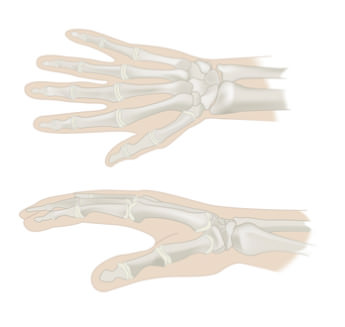

What is a fracture?
Most everyone knows a fracture is a broken bone, but you might find it helpful to know that although there are many different types of fractures. Common breaks fall into two general categories: non-displaced or displaced.
Non-displaced fracture:
- Bone is broken
- Bone is not shifted or moved out of position
Displaced fracture:
- Gap between the two ends of the bone
- Bones not aligned properly
Fractures can also be:
- Closed: skin is intact
- Open or compound: skin is open with a high risk of infection
- Partial or incomplete
What causes a fracture in your hand or wrist?
Fractures typically occur because some type of trauma puts force or impact on a bone and it breaks. A classic example is when someone falls and lands on an outstretched hand or wrist. The force from the fall in combination with the angle of the wrist may be sufficient to cause a fracture or break in the bone. More than one million fractures occur every year in the United States.
Some of the most common causes:
- Sports injuries
- Car accidents
- Falls
Disease can also be a cause:
- Cancer
- Osteoporosis (bone weakening due to aging)
What symptoms should I be aware of?
Symptoms can vary greatly and your fracture may or may not show some the symptoms listed here.
Broken wrist symptoms may include:
- Wrist pain
- Swelling in the wrist and/or hand
- Bruising
- Decreased use of hand and wrist
- A crooked or deformed appearance
- Unable to hold a grip
Hand fracture symptoms may include:
- Pain
- Swelling
- Tenderness to touch
- Stiffness
- Weakness
How do I know if my wrist or hand is broken?
Many fractures can be diagnosed through x-ray and a complete physical exam. To obtain a more detailed look at the bones, joint surface, and ligaments, your Summit hand surgeon may also request:
- MRI (Magnetic Resonance Imaging)
- Bone scan
- CT or CAT (Computer Tomography) scan
What are my treatment options?
A bone fracture is typically immobilized in order to correct bone alignment and prevent use of the bone while it heals.
Your custom treatment plan may include:
- Cast and/or splint
- Wrapping
- Pain medications
- Anti-inflammatory medications
- Physical therapy
- Surgery
How long will it take my fracture to heal?
It depends. Your healing process is as individual as you are. Much depends on the type and location of the fracture, your age, health, and general physical well-being. The average healing process for a broken bone is anywhere from six to eight weeks. It may be slightly longer if surgery is required. At Summit, our primary goal is to make sure your bones heal properly so you can get back to your everyday active life as quickly as possible without any future symptoms or loss of function.
